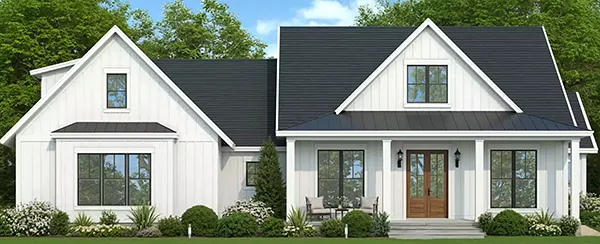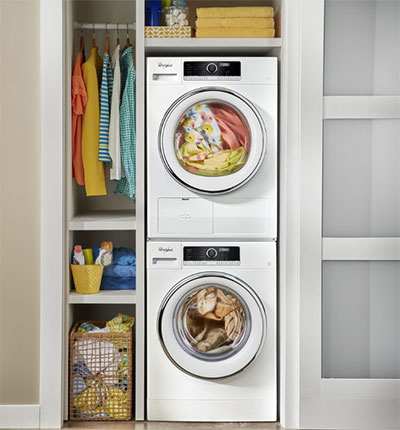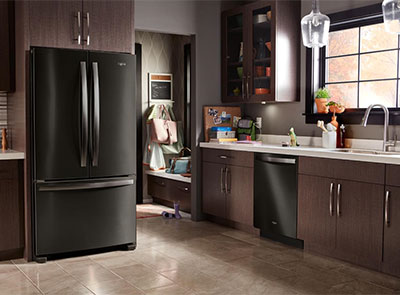Selecting Energy Efficient Home Appliances
by Rachel Lyon, Editorial Director for The House Designers
You consider R-values, U-factors, and maybe even SHGCs when you build your own home, so don’t forget about certain interior features that also affect household efficiency. Appliances can suck up a lot of power and contribute to high electricity bills over their lifetimes, so it’s in your interest to shop for models that reduce costs. In general, newer ones incorporate energy-saving hardware and technology not available in the past, but you should focus on those that are ENERGY STAR® rated, which use 20-30% less energy than mandated by federal standards. Here’s some technology and the latest appliances that caught our eco-conscious eyes!
Heat Recycling Dryers
Of your laundry set, it’s the dryer that has the most room for improvement in terms of efficiency. Consider the traditional design we all know: room temperature air is drawn in and heated up, and directed to the drum where it dries the load by absorbing moisture, and then that heat and humidity are sent outside through an exhaust vent. Those steps repeat for as long as it takes to dry, so you can imagine just how much electricity or gas is used for heat that gets discarded continuously. Some such models are better than others, but ventless dryers are specifically designed to eliminate this huge source of waste.
Ventless dryers heat air and direct it to the drum to absorb moisture, and then the humid air is pumped through an evaporator. This removes moisture through condensation, storing the water in a reservoir that you must empty like you do the lint trap, and the newly dry hot air is brought back to the drum to repeat the process. These dryers don’t reach temperatures as high as traditional vented ones and can take longer to dry, but they are much gentler on clothes as a result. The ventless system has been preferred in Europe for years not only for the unbeatable efficiency that heat recycling offers, but because it allows almost any place to become the laundry room. That’s a major selling point whether you’re in a tight apartment, or an old building that you can’t retrofit for dryer vents, or you want the flexibility to move your laundry set somewhere for optimal convenience or to conceal it from view.
Buying efficient appliances is a great start to living a less expensive and more environmentally conscious lifestyle, but you must also use and maintain them correctly to reap the biggest benefits and make the biggest impact. The washing and drying options on machines consume vastly different amounts of energy, so your choices matter. For example, heating hot water for the washer consumes 90% of the energy needed to run the load, so opting for warm or cold water is much "greener." See the Laundry Appliance Best Practices from ENERGY STAR® for more tips to save energy and keep your washer and dryer in good working order.
Well-Designed Kitchen Appliances
The refrigerator is, by far, the largest energy hog in your kitchen. It runs 24/7 and it has to use more power every time you open the door. Just due to the nature of the job, even efficient refrigerators with the best insulation and compressors use more energy than the rest of the kitchen, so it is important to give the fridge priority if you can’t purchase an efficient model of every appliance.
When you look for a fridge, there are a few key characteristics to keep in mind. Top-freezer models are inherently more efficient than those with freezers on the side or bottom because the compressor—which gets hot as it works to cool the interior—is located at the bottom and farther from the space that needs to be the coldest. There are still plenty of bottom-freezer fridges that are ENERGY STAR® certified, but it’s much rarer to find qualified side-by-side models as they consume the most electricity. No matter the configuration, you want to make sure the refrigerator has good weatherstripping to prevent air leakage, and you should keep the condenser area clean and give it space for airflow so it doesn’t get too hot and have to work against itself.
Next, consider the dishwasher. Water usage most distinguishes the efficient from the inefficient in this case. Targeted jets, better rack designs, soil sensors, and water filters can make all the difference by doing more with less. When less water can get the job done, less electricity is needed to move and heat it, so new dishwashers with these features can save two-fold.
Besides saving every month on your bills, efficient appliances offer extra monetary incentives in the form of rebates and tax breaks—so don’t be put off by the higher price tag upfront. You can use ENERGY STAR’s® Rebate Finder to discover what offers are available in your area and how to get them. Depending on where you live and what you buy, you could be in for hundreds or even thousands of dollars back on your major appliances, HVAC system, water heater, television, light bulbs, and more.
The Whirlpool® appliances we’ve shown here are just the tip of the iceberg. Whirlpool Corporation earned the coveted Partner of the Year – Sustained Excellence designation from ENERGY STAR® in 2017 for its continued efforts producing and promoting appliances that are certified energy efficient. With laundry sets and kitchen suites that are beautiful, functional, and varied enough to address the wants and needs of all kinds of customers, you’re sure to find fantastic appliances for your home and the environment!



.png)
.png)



